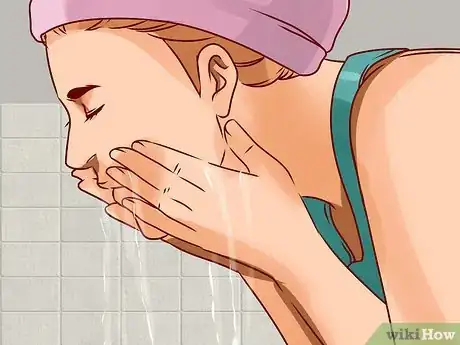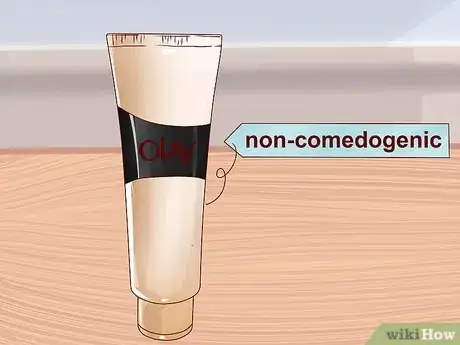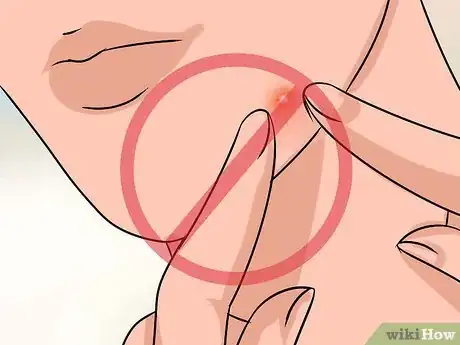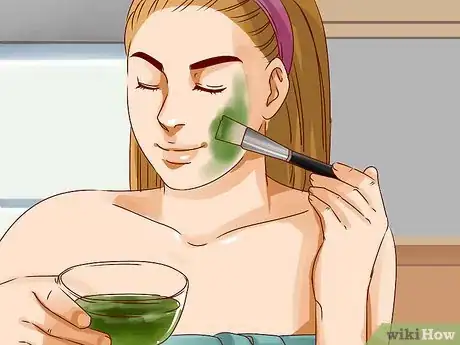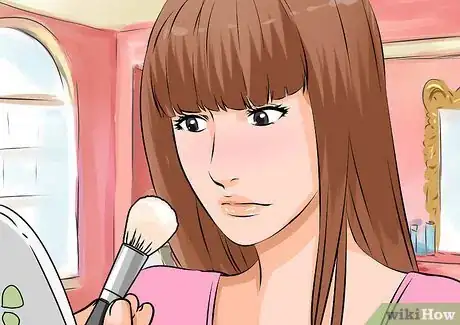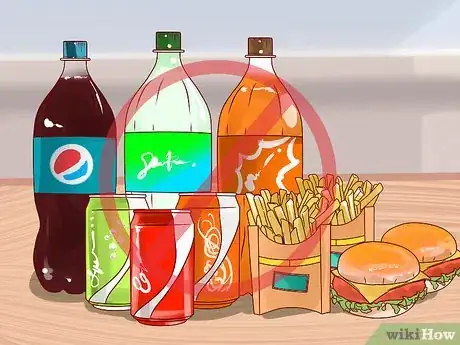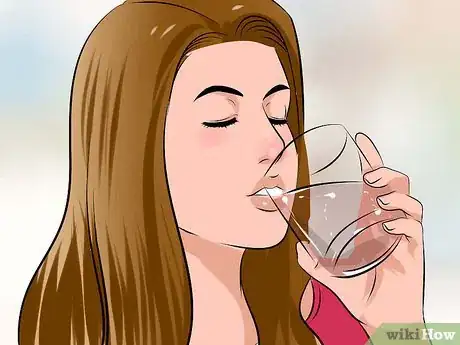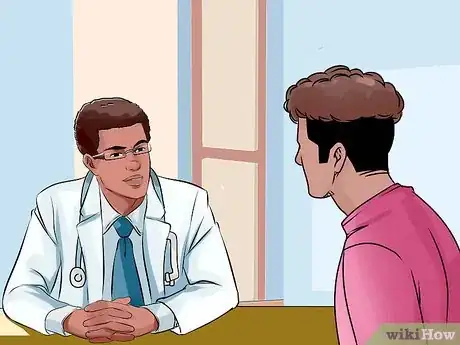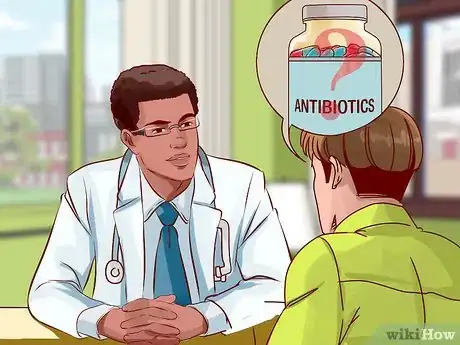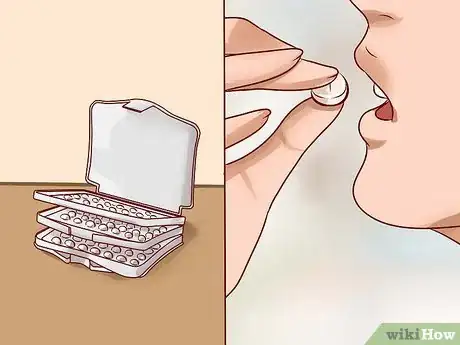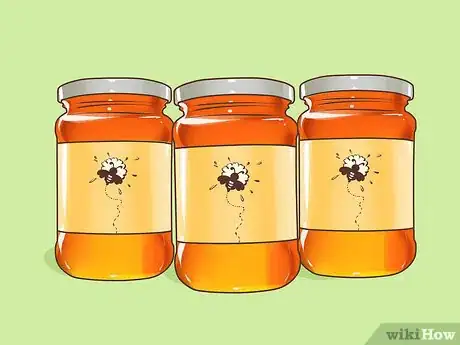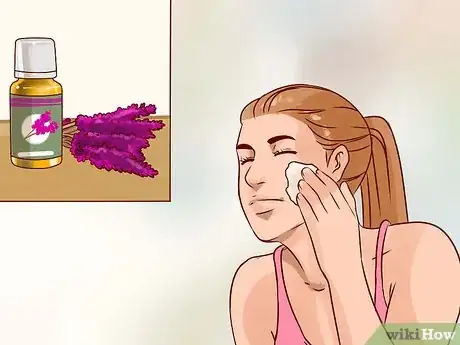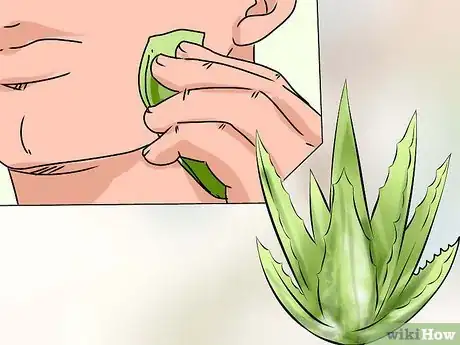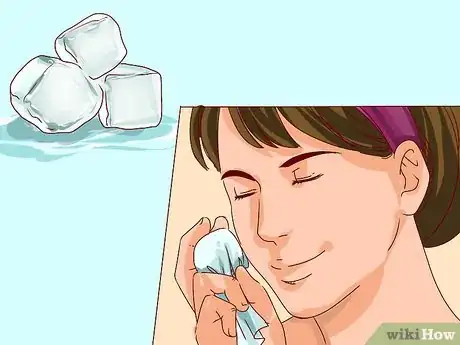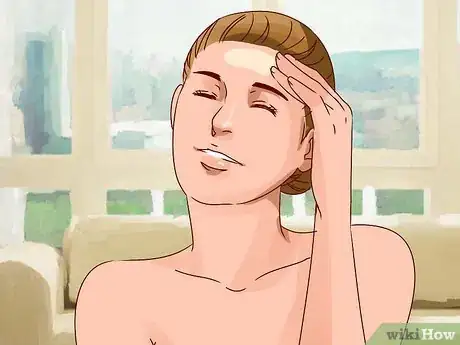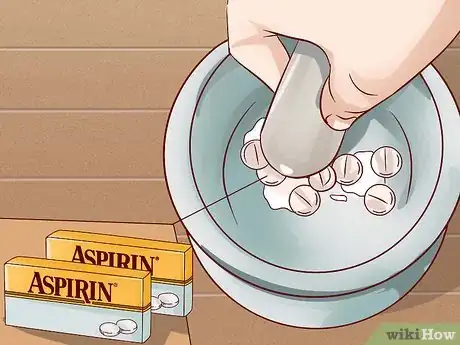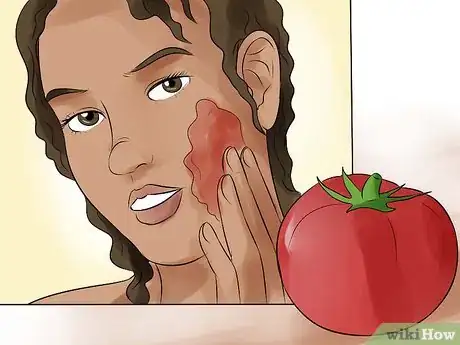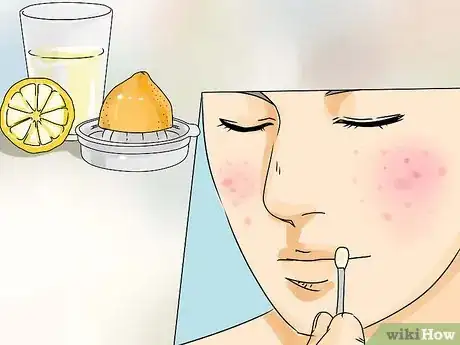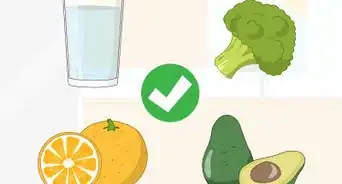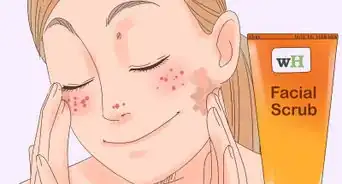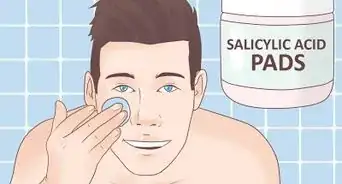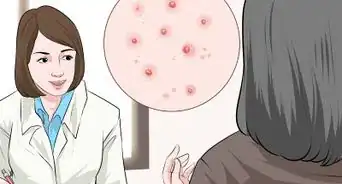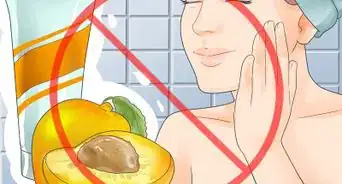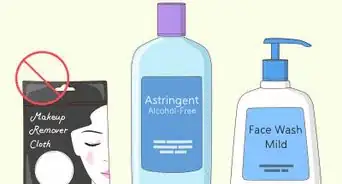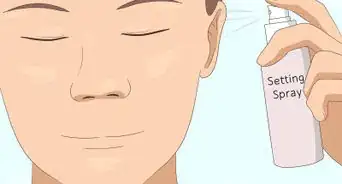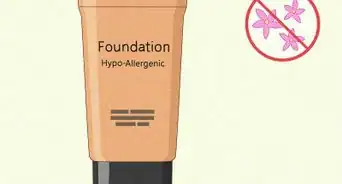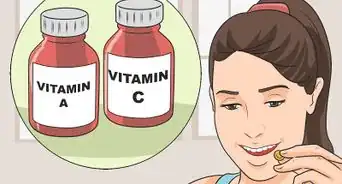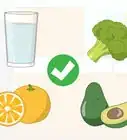This article was co-authored by Paul Friedman, MD. Paul Friedman, MD, is a Board-Certified Dermatologist, and the Director and Founder of the Dermatology & Laser Surgery Center in Houston, Texas. He has over 25 years of experience and specializes in Mohs micrographic surgery, dermatologic laser surgery, and cosmetic dermatology. Dr. Friedman is the current President of the American Society for Laser Medicine & Surgery and was named by Newsweek Magazine as one of the Best Dermatologists in America for Laser Treatments. His awards include the Husk Prize for his research in dermatologic surgery and the Young Investigator's Writing Competition Award of the American Society for Dermatologic Surgery. Dr. Friedman completed his dermatology residency at the New York University School of Medicine and received his medical degree with the highest honors from the University of Tennessee Health Science Center, College of Medicine.
There are 10 references cited in this article, which can be found at the bottom of the page.
wikiHow marks an article as reader-approved once it receives enough positive feedback. This article received 68 testimonials and 80% of readers who voted found it helpful, earning it our reader-approved status.
This article has been viewed 3,977,118 times.
Zits, spots, pimples... call them what you will, but they are an unfortunate skin problem that most people have to deal with at some point in their lives. Luckily, there are many, many options when it comes to getting those pesky pimples under control, from rigorous skin care regimens to medications, herbs, and creams, to innovative home remedies. Finding what works for you may be a process of trial and error, but not to worry -- this article contains a solution for everybody!
Steps
Caring For Your Skin
-
1Wash your face twice a day. It is very important to keep your face clean when trying to prevent pimples. Washing your face removes dirt, impurities and any excess oil that has built up on the surface of your skin.[1] Ideally, you should wash your face three times a day, in the morning and noon and in the evening, using warm water and a mild facial cleanser. Use a clean dry towel to pat your face dry.
- Avoid scrubbing your face with a rough washcloth, sponge or loofah. This will only irritate the skin and cause pimples to become even more inflamed. Washcloths may also harbor bacteria, which you want to avoid putting in contact with your face.
- Even though you may be tempted to wash your face more than twice a day if you're suffering from pimples, be aware that this will not necessarily help your skin. Washing your face too often can dry out the skin and cause it to become irritated.[2]
-
2Use a noncomedogenic moisturizer. After washing it is important to apply a good moisturizer to hydrate the skin and prevent it from becoming dry and irritated. However, if you suffer from pimples it is important that you use the right type of moisturizer for your skin type.[3] Heavy, oily moisturizers can clog your pores and lead to further breakouts. Look for moisturizers which say "noncomedogenic" on the label -- this means that they should not cause your skin to breakout.
- In addition to looking out for noncomedogenic moisturizers, you should be careful to choose a product that suits your skin type. For example, if you have very oily skin you may want to use a lighter, gel-based moisturizer, whereas if you have dry, flaky skin, you may need a heavier, cream-based one.
- Make sure you wash your hands immediately before applying moisturizer. Otherwise, any bacteria or germs on your hands may be transferred to your face when you apply your moisturizer.
Advertisement -
3Avoid touching your face or popping pimples. Hands come into contact with more dirt and bacteria throughout the day than any other part of the body, which is why you should avoid touching your face at all costs. In addition to spreading bacteria and risking infection, touching spots and pimples can cause them to become irritated and inflamed, thus worsening their appearance and prolonging healing time.
- Popping pimples, however satisfying it may feel, is one of the worst things you can do for your skin. Popping pimples will only prolong their healing time and may even lead to infection and scarring. Acne scars can be very difficult to get rid of, so you will want to avoid this as far as possible.
- It is very easy to touch your face without being aware of what you are doing. Be wary of propping your cheek or chin up with your hand when sitting at a desk or table, or of resting your face on your hand in bed at night.
-
4Use exfoliating treatments and face masks once a week. Skin exfoliators and face masks are great products which can be very beneficial for the skin, but they should only be used sparingly. Exfoliators remove dead skin cells while effectively cleansing the skin, but can be dry out and irritate the skin if used too often, especially on pimple-prone skin.[4]
- Face masks are great for cleansing impurities and calming the skin, and can turn your regular skin care routine into a spa-like experience. Yet again, they should be limited to about once a week, as they may contain harsher ingredients that are not intended for everyday use.
-
5Avoid overloading your skin with products. Too many creams, lotions, and gels can clog your pores and lead to breakouts, so make sure to apply any facial products sparingly, and no more frequently than is indicated on the packaging. The same goes for make-up, which should be applied as lightly as possible and should be thoroughly removed using a facial cleanser at the end of each day.
- Heavily fragranced or chemical-laden hair products may also clog the pores if hair comes in contact with the face, so avoid using these whenever possible. Use a gentle shampoo and conditioner which won't irritate your skin in the shower.
- You should also limit your skin's exposure to built-up oils and bacteria by changing your pillowcase at least once a week and by washing any makeup brushes frequently.
-
6Protect your skin from the sun. Although traditional advice encouraged the exposure of pimple-prone skin to the sun, with the belief that this would dry pimples out, modern-day skin specialists say otherwise. The sun's UV rays can actually cause pimples to become even redder and inflamed than before.
- For this reason, it is important to protect your skin from sunlight by wearing a protective hat and applying a sunscreen with an SPF of 30 or higher.
- Be aware that some sunscreens can be oily and may clog the pores, so look for products that state "noncomedogenic" on the label.
-
7Eat well. Although it's been proven that chocolate and other junk food don't actually cause pimples, staying away from oily, greasy foods can still have a positive effect on your skin. Pimples form when excess oil clogs up your pores, so limiting the amount of oil that you put into your body in the first place is a step in the right direction. Plus, if your body is healthy on the inside, that will be reflected on the outside.
- Stay away from foods like potato chips, chocolate, pizza and fries. These foods are high in fat, sugar and starch, which is not good news for your skin or your overall health. You don't need to deprive yourself completely, just try to limit your intake a little.
- Eat plenty of fresh fruit and vegetables. Their water content helps to hydrate the skin while their vitamins and minerals give your body the ammunition it needs to fight pimples. In particular, try to eat fruit and veg with a high vitamin A content (such as broccoli, spinach and carrots) as this helps to flush acne-causing proteins from the system, and with high vitamin E and C contents (oranges, tomatoes, sweet potatoes, avocados) which have antioxidant effects and help to calm the skin.[5]
-
8Drink plenty of water. Drinking water has many benefits, for the skin and for the body's overall health. It keeps the body hydrated, helping skin to look firm and plump. It flushes harmful toxins from the system, preventing them from building up and causing skin problems. In addition, water helps ensure the proper function of the skin's metabolism and allows it to regenerate itself. You should aim to drink 5 to 8 glasses of water a day to reap the benefits.
- There is such a thing as drinking too much water, however, so don't feel like you have to be drinking constantly. Too much water dilutes the blood and can put your health at risk, leading to seizures in extreme cases. Stick around the 8 glass mark, and you'll be fine.[6]
- You should also try to stay away from excessive alcohol consumption. Alcohol upsets your hormone balance, and an imbalance of hormones such as testosterone and oestrogen is one of the major causes of acne. In addition, alcohol causes damage to the liver, which is the main organ responsible for healthy skin, as it regulates hormones and blood sugar levels, and filters toxins.
Using Creams, Medications and Treatments
-
1Use an over-the-counter cream. If you suffer from persistent pimples, it will usually be necessary to do a little more than simply keep your face clean and eat healthily. Luckily, there are a whole plethora of over-the-counter (OTC) creams which can work wonders for clearing up pimples and prevent more from popping up in their place.[7] These creams are usually applied directly onto pimples and will, in most cases, lead to a significant improvement in the skin's condition within 6 to 8 weeks. The most common active ingredients found in these creams are:
- Benzoyl peroxide. Benzoyl peroxide kills bacteria on the surface of the skin, while also slowing down the production and build-up of oil in the pores. It also works as a peeling agent, helping the skin to rejuvenate itself. Benzoyl peroxide can have a drying, irritating effect on the skin, so you should begin with the lowest available concentration.
- Salicylic acid. Salicylic acid is another ingredient which helps to kill pimple-causing bacteria. It also helps to break down blackheads and whiteheads which can develop into pimples once infected. In addition, salicylic acid helps skin to shed old, dead layers, preventing pores from becoming blocked and allowing new skin cells to form.
- Sulfur. Sulfur contains anti-bacterial properties and helps to break down whiteheads and blackheads, preventing them from becoming infected and forming pimples.
- Retin-A. Retin-A contains an acidic form of vitamin A, known as all-trans retinoic acid, which operates like a chemical peel, exfoliating the skin and unblocking clogged pores.
- Azelaic acid. Azelaic acid minimizes the appearance of pimples by preventing the build-up of oil and reducing inflammation and bacterial growth. It is especially effective for people with darker skin tones.[8]
-
2Ask a dermatologist to prescribe a stronger topical cream. Some people find that OTC creams are not quite strong enough to combat stubborn pimples. In this case, it is possible to ask your doctor to prescribe a stronger topical treatment which might just do the trick.
- Most prescription creams contain active ingredients derived from vitamin A. Examples include products such as tretinoin, adapalene, and tazarotene. These creams work by encouraging cell turnover and by preventing hair follicles from becoming clogged.[9]
- There are also a number of prescription antibacterial creams, which work by killing bacteria on the surface of the skin.
-
3Think about taking a course of antibiotics. In cases of moderate to severe acne, your doctor may recommend combining the application of a topical cream with a course of oral antibiotics. These help to reduce inflammation along with the growth of bacteria. Antibiotic treatments will usually last between four and six months, although you should begin to notice an improvement in your skin within about six weeks.
- Unfortunately, many people nowadays easily build up a resistance to antibiotics, so this form of treatment will not always work effectively.
- Some antibiotics (such as tetracyclines) will reduce the effectiveness of oral contraceptives, so women should use a backup form of contraception when following a course of antibiotics.[8]
-
4In case of severe acne, consider isotretinoin treatments. If all else fails and severe acne persists, your dermatologist may advise isotretinoin treatments. Isotretinoin is closely related to vitamin A and works by reducing the body's production of sebum oil and by shrinking the oil-producing glands. A course of isotretinoin usually lasts for about 20 weeks, during which time the patient must be closely monitored, due to the drug's large number of potential side effects.
- When taking isotretinoin, acne may become worse before it gets better. This flare-up will usually only last for a couple of weeks but can sometimes last for the duration of the treatment.
- Some of the side effects associated with isotretinoin treatments include dry skin and eyes, dry, cracked lips, sensitivity to sunlight, and more uncommonly, headaches, hair loss, mood changes and depression.
- This treatment has been linked to severe birth defects, so it cannot be prescribed to pregnant women or those who are trying to conceive. As a result, women will be asked to take a pregnancy test before being prescribed this medication.
-
5If you are female, think about using oral contraceptives. Since many pimple problems are related to hormonal imbalances, oral contraceptives can be a great way of regulating hormone production and reducing breakouts in women - particularly those related to the menstrual cycle. Oral contraceptives which contain a combination of norgestimate and ethinyl estradiol are generally the most effective.
- Oral contraceptives can in rare cases produce serious side effects such as blood clotting, high blood pressure and a higher risk of heart disease, so make sure to discuss this option thoroughly with your doctor before pursuing it.[9]
-
6Find out about professional treatments. There are many treatments available at spas and skin clinics, which can significantly improve the appearance of pimple-prone skin, when used in combination with some of the above-mentioned treatments. They can be a little on the pricey side, but can produce more long-term results than other treatments and even help to prevent and reduce scarring. Such treatments include:
- Laser therapy. Laser therapy works by penetrating deep within the skin and damaging the oil glands that produce sebum - an excess of which leads to pimples.
- Light therapy. Light therapy targets the acne-causing bacteria on the surface of the skin, reducing inflammation and improving the texture of the skin.
- Chemical peels. A chemical peel burns the surface of the skin in a controlled fashion, causing the top layers to peel away and revealing the fresh, new skin underneath. This treatment is particularly good for getting rid of any marks or scars left behind after the pimples themselves have been cleared away.
- Microdermabrasion. Microdermabrasion uses a rotating wire brush to exfoliate the top layers of skin, revealing the smooth new skin underneath. It can be somewhat uncomfortable and can leave the skin looking red and raw for a number of days until it has fully healed.
Using Home Remedies
Herbal remedies
-
1Use tea tree oil. Tea tree oil is one of the best natural spot treatments available. Extracted from the leaves of the Australian melaleuca alternifolia plant, tea tree oil possesses powerful antibacterial, antifungal and antiviral properties which effectively combat the pimple-causing bacteria on the skin. Simply apply a drop or two of pure tea tree oil onto a clean q-tip and dab directly onto the offending pimple. Do this twice a day and the pimple should be gone in no time!
- Tea tree oil is an essential oil and therefore extremely concentrated. If you overuse the oil or apply it undiluted to unaffected skin, your skin may become dry and irritated, so use sparingly, and only when needed.
- One study found that tee tree oil was just as effective at combating pimples as its chemical-laden counterpart benzoyl peroxide. The tea tree oil did take slightly longer to take effect, but also produced fewer negative side effects.[10]
-
2Apply honey. Honey is an amazing natural healing product, whose antibacterial, antiseptic and hydrating properties make it an excellent choice for fighting pimples, particularly if you have sensitive skin. Manuka honey is the best bet for calming angry pimples, but raw honey will also work well.
- You can apply the honey as a spot treatment, or use it as a face mask, applying it all over the face on clean, slightly damp skin. As honey is non-irritating, you can leave it on for as long as you like.
- One point that must be made is that honey, like many other home remedies, works to clear up pre-existing pimples (due to its anti-bacterial nature) but will do little to prevent future pimples from popping up (especially those caused by hormonal imbalances).[11]
-
3Try lavender essential oil. Lavender essential oil, famous mainly for its calming and soothing properties, can also be used as a spot treatment for pimples, much like tea tree oil. Lavender oil is often used on burns, as it contains healing properties which can also be beneficial for pimples. In addition, lavender oil contains powerful antibacterial agents, which help to cleanse pores, minimizing the appearance of pimples.
- To use, apply a dab of undiluted oil directly onto the pimple using a q-tip. Take care not to get any on the surrounding skin, as lavender oil can be irritating on the skin when undiluted.
-
4Use aloe vera. Take a big piece of aloe vera. Rub it on the pimpled place. Massage on the skin with the aloe vera on the pimple zone. Leave it for half an hour. Wash it off with hot water.
Cold remedies
-
1Try an ice cube. Pimples often make their presence felt by becoming red and inflamed, so what better way to cool off an angry pimple than with some soothing ice? The ice reduces inflammation and redness, significantly improving the appearance of the pimple. Simply wrap an ice cub in some paper towel or a clean cloth and press gently against the pimple for a minute or two.
- An additional tip is to make ice cubes from strong green tea and use these on the pimples instead. In addition to its anti-inflammatory and antibacterial properties, studies have shown that a certain antioxidant green tea can actually help to reduce sebum production.
Bathroom remedies
-
1Use toothpaste. The notion of applying toothpaste on problem pimples has been around for years, and while it may not be the most effective spot treatment available, it will do in a pinch. Toothpaste contains ingredients such as baking soda and hydrogen peroxide which dry out pimples, helping them to go away faster.
- Opt for an all-white, fluoride-free toothpaste, if possible, and make sure that you apply it directly onto the pimple, rather than on the surrounding skin, as other ingredients in the toothpaste may irritate and even burn the skin.[12]
-
2Apply a crushed up aspirin. The technical name for aspirin is acetylsalicylic acid, which is closely related to salicylic acid, a well-known and popular acne treatment. Aspirin is an anti-inflammatory which can help to reduce the size and redness of pimples, when applied topically. All you need to do is crush up an aspirin tablet and add a drop or two of water to form a paste, which can then be applied directly onto each pimple.
- Alternatively, you can make a face mask by crushing up five or six aspirin tabs and adding enough water to make a paste. This can be applied all over the face and left on for about ten to fifteen minutes, before washing off.[13]
Kitchen remedies
-
1Use tomato. Tomatoes are a handy home remedy for pimples, as most people tend to have a tomato or two floating around their kitchen. Tomatoes are packed with vitamins A and C which, as mentioned above, are prime pimple-busting material. Tomato juice is also a natural astringent, which causes the surface of the pimple to contract and shrink.
- To use, simply cut up a fresh tomato and rub the juice from a slice directly onto the target pimple. Do this twice a day and you should begin to notice an improvement.
-
2Apply fresh lemon juice. Applying fresh lemon juice to pimples is one of most popular home remedies out there. Lemons contain high quantities of vitamin C, along with citric acid which helps to both exfoliate and dry out pimples. Lemon juice also contains bleaching agents which can significantly reduce the redness of the pimples. A little fresh lemon juice can be applied directly to each pimple before bed and left on overnight.
- Lemon juice should not be applied to your skin during the day, unless you plan on staying indoors. This is because the juice makes your skin photosensitive, increasing the risk of sun damage.[14]
- As with many other home remedies, the lemon juice should only be applied directly onto the pimple, and not on the surrounding skin. This is due to the chance of the citric acid in lemons burning the skin.
Expert Q&A
-
QuestionHow do you bring a pimple to the surface?
 Margareth Pierre-Louis, MDDr. Margareth Pierre-Louis is a board certified Dermatologist and Dermatopathologist, Physician Entrepreneur, and the Founder of Twin Cities Dermatology Center and Equation Skin Care in Minneapolis, Minnesota. Twin Cities Dermatology Center is a comprehensive dermatology clinic treating patients of all ages through clinical dermatology, cosmetic dermatology, and telemedicine. Equation Skin Care was created to provide the best in evidence-based, natural skin care products. Dr. Pierre-Louis earned a BS in Biology and an MBA from Duke University, an MD from the University of North Carolina at Chapel Hill, completed a residency in dermatology at the University of Minnesota, and completed a dermatopathology fellowship at Washington University in St Louis. Dr. Pierre-Louis is board certified in dermatology, cutaneous surgery, and dermatopathology by the American Boards of Dermatology and Pathology.
Margareth Pierre-Louis, MDDr. Margareth Pierre-Louis is a board certified Dermatologist and Dermatopathologist, Physician Entrepreneur, and the Founder of Twin Cities Dermatology Center and Equation Skin Care in Minneapolis, Minnesota. Twin Cities Dermatology Center is a comprehensive dermatology clinic treating patients of all ages through clinical dermatology, cosmetic dermatology, and telemedicine. Equation Skin Care was created to provide the best in evidence-based, natural skin care products. Dr. Pierre-Louis earned a BS in Biology and an MBA from Duke University, an MD from the University of North Carolina at Chapel Hill, completed a residency in dermatology at the University of Minnesota, and completed a dermatopathology fellowship at Washington University in St Louis. Dr. Pierre-Louis is board certified in dermatology, cutaneous surgery, and dermatopathology by the American Boards of Dermatology and Pathology.
Board Certified Dermatologist
-
QuestionHow do I stop getting pimples on my face?
 Paul Friedman, MDPaul Friedman, MD, is a Board-Certified Dermatologist, and the Director and Founder of the Dermatology & Laser Surgery Center in Houston, Texas. He has over 25 years of experience and specializes in Mohs micrographic surgery, dermatologic laser surgery, and cosmetic dermatology. Dr. Friedman is the current President of the American Society for Laser Medicine & Surgery and was named by Newsweek Magazine as one of the Best Dermatologists in America for Laser Treatments. His awards include the Husk Prize for his research in dermatologic surgery and the Young Investigator's Writing Competition Award of the American Society for Dermatologic Surgery. Dr. Friedman completed his dermatology residency at the New York University School of Medicine and received his medical degree with the highest honors from the University of Tennessee Health Science Center, College of Medicine.
Paul Friedman, MDPaul Friedman, MD, is a Board-Certified Dermatologist, and the Director and Founder of the Dermatology & Laser Surgery Center in Houston, Texas. He has over 25 years of experience and specializes in Mohs micrographic surgery, dermatologic laser surgery, and cosmetic dermatology. Dr. Friedman is the current President of the American Society for Laser Medicine & Surgery and was named by Newsweek Magazine as one of the Best Dermatologists in America for Laser Treatments. His awards include the Husk Prize for his research in dermatologic surgery and the Young Investigator's Writing Competition Award of the American Society for Dermatologic Surgery. Dr. Friedman completed his dermatology residency at the New York University School of Medicine and received his medical degree with the highest honors from the University of Tennessee Health Science Center, College of Medicine.
Board Certified Dermatologist, American Board of Dermatology What works best will vary based on the type of acne that you have, but cleansers containing salicylic acid or glycolic acid can be useful for opening up clogged pores and improving acne. It's important to wash your face twice a day, especially at the end of the day, to remove the debris and oil that accumulates on your skin as well as any makeup you may be wearing.
What works best will vary based on the type of acne that you have, but cleansers containing salicylic acid or glycolic acid can be useful for opening up clogged pores and improving acne. It's important to wash your face twice a day, especially at the end of the day, to remove the debris and oil that accumulates on your skin as well as any makeup you may be wearing. -
QuestionHow can I get clear skin overnight?
 Paul Friedman, MDPaul Friedman, MD, is a Board-Certified Dermatologist, and the Director and Founder of the Dermatology & Laser Surgery Center in Houston, Texas. He has over 25 years of experience and specializes in Mohs micrographic surgery, dermatologic laser surgery, and cosmetic dermatology. Dr. Friedman is the current President of the American Society for Laser Medicine & Surgery and was named by Newsweek Magazine as one of the Best Dermatologists in America for Laser Treatments. His awards include the Husk Prize for his research in dermatologic surgery and the Young Investigator's Writing Competition Award of the American Society for Dermatologic Surgery. Dr. Friedman completed his dermatology residency at the New York University School of Medicine and received his medical degree with the highest honors from the University of Tennessee Health Science Center, College of Medicine.
Paul Friedman, MDPaul Friedman, MD, is a Board-Certified Dermatologist, and the Director and Founder of the Dermatology & Laser Surgery Center in Houston, Texas. He has over 25 years of experience and specializes in Mohs micrographic surgery, dermatologic laser surgery, and cosmetic dermatology. Dr. Friedman is the current President of the American Society for Laser Medicine & Surgery and was named by Newsweek Magazine as one of the Best Dermatologists in America for Laser Treatments. His awards include the Husk Prize for his research in dermatologic surgery and the Young Investigator's Writing Competition Award of the American Society for Dermatologic Surgery. Dr. Friedman completed his dermatology residency at the New York University School of Medicine and received his medical degree with the highest honors from the University of Tennessee Health Science Center, College of Medicine.
Board Certified Dermatologist, American Board of Dermatology Products such as Differin, which is a vitamin A cream, are very good over-the-counter medications that work well for certain types of acne. If you have an isolated acne lesion, you also have the option of going into a dermatologist's office for an injection of an intralesional steroid. The process must be done by an experienced dermatologist, but that would be the main mechanism in terms of quickness of response.
Products such as Differin, which is a vitamin A cream, are very good over-the-counter medications that work well for certain types of acne. If you have an isolated acne lesion, you also have the option of going into a dermatologist's office for an injection of an intralesional steroid. The process must be done by an experienced dermatologist, but that would be the main mechanism in terms of quickness of response.
Warnings
- Discontinue use of any medications that irritate your skin. That's it and enjoy your pimple free skin.⧼thumbs_response⧽
- Most home remedies are not backed up by modern science and will not work for everybody. When it comes to natural treatments, it may be a process of trial and error to find out what works for you.⧼thumbs_response⧽
References
- ↑ Paul Friedman, MD. Board Certified Dermatologist, American Board of Dermatology. Expert Interview. 8 April 2020.
- ↑ Paul Friedman, MD. Board Certified Dermatologist, American Board of Dermatology. Expert Interview. 8 April 2020.
- ↑ Paul Friedman, MD. Board Certified Dermatologist, American Board of Dermatology. Expert Interview. 8 April 2020.
- ↑ Paul Friedman, MD. Board Certified Dermatologist, American Board of Dermatology. Expert Interview. 8 April 2020.
- ↑ http://www.webmd.com/skin-problems-and-treatments/acne/acne-care-11/diet-and-skin?page=1
- ↑ http://www.webmd.com/skin-problems-and-treatments/acne/acne-care-11/diet-and-skin?page=2
- ↑ Paul Friedman, MD. Board Certified Dermatologist, American Board of Dermatology. Expert Interview. 8 April 2020.
- ↑ 8.08.1http://www.medicalnewstoday.com/articles/191530.php
- ↑ 9.09.1https://www.mayoclinic.org/diseases-conditions/acne/diagnosis-treatment/drc-20368048
- ↑ http://well.blogs.nytimes.com/2011/01/27/remedies-tea-tree-oil-for-acne/?_r=0
- ↑ http://www.skinacea.com/acne/acne-treatment-honey.html#.VqOo9lIYLm5
- ↑ http://www.huffingtonpost.com/2012/10/23/toothpaste-pimples-acne-dry-out_n_1994320.html
- ↑ https://www.ncbi.nlm.nih.gov/pmc/articles/PMC4554394/
- ↑ http://www.crunchybetty.com/9-pretty-simple-pimple-home-remedies
- ↑ https://www.webmd.com/skin-problems-and-treatments/acne/features/lifestyle#1
- ↑ https://www.webmd.com/skin-problems-and-treatments/acne/features/stress-and-acne#1
About This Article
If washing your face daily with a mild cleanser hasn’t helped your breakouts, try applying an over-the-counter cream made with benzoyl peroxide or salicylic acid directly onto the pimples. If you prefer a natural method, applying tea tree oil, lavender essential oil, or honey to the pimple may help to speed healing. You may also find relief by applying a paste from crushed up aspirin mixed with a little water, then rinsing it off after about 10-15 minutes. If you want to learn more about how to keep your skin clear and healthy, keep reading the article!
